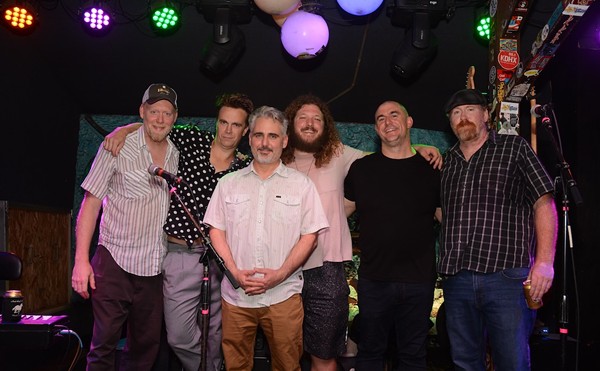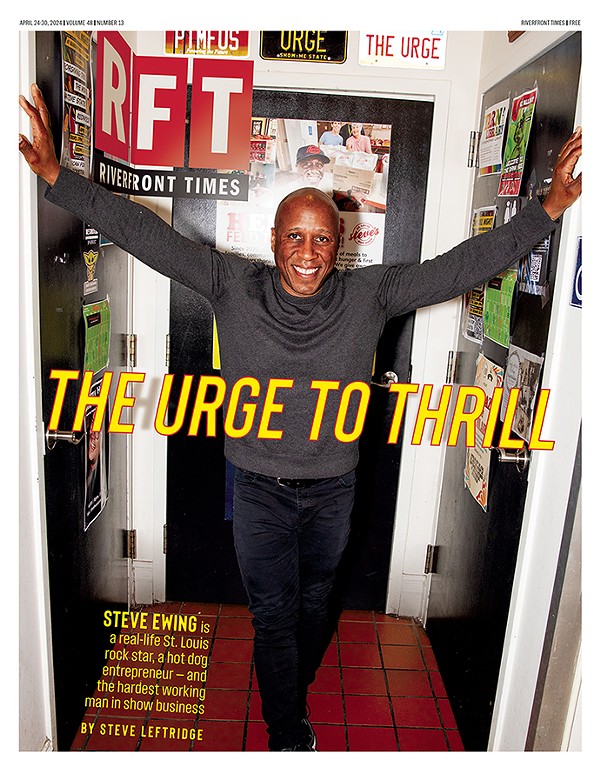Hide your women. Hide the children. Glammed-up synth-punkers The Killers are coming to town in support of their platinum-selling Hot Fuss, and there just might be Hell to pay. We took a look at how the retro-rockers-of-the-moment compared to some real killers in history, and let us tell you: It ain't pretty.
"Blood Countess" Báthory: In seventeenth-century Hungary, the cold-blooded Countess Erzsébet Báthory reportedly killed women for sport and bathed in their blood to make herself beautiful. She changed her clothing five or six times a day and spent hours admiring her legendary beauty in mirrors.
The Killers: The ruthless Killers have recently engaged in a little bloodsport of their own, claiming similarly coiffed labelmates The Bravery and their lead singer, Sam Endicott, stole the band's look, style and sound. Gonna have to side with The Bravery on this one, but both bands clearly spend a lot of time in front of the mirror admiring their 'dos. And as far as the lady-killing goes, neither group seems to be having too much difficulty.
Gavrilo Princip: This notorious assassin executed Archduke Franz Ferdinand of Austria on June 28, 1914, which caused Austria to declare war on Serbia, thus triggering a minor affair we like to call World War I.
The Killers: Likewise, The Killers are slaughtering Franz Ferdinand, the Glasgow-based synth-heavy post-punk act to which they're most frequently compared. While Hot Fuss rests comfortably on top of the Billboard charts, the saucy Scots (who've stated they aim to make "music girls can dance to") haven't seen nearly the same success with their catchy self-titled debut.
Joe Hunt: An '80s psychopathic murdering fave, good ol' Joe captured the popular imagination as leader of the Billionaire Boys Club. Besides serving as the subject of a must-see NBC Movie of the Week starring Brat Packer Judd Nelson, Hunt managed to convince his fellow investment-club members to kill several of their wealthy clients in a twisted scheme involving kidnapping, Swiss bank accounts and well-dressed prepsters.
The Killers: The Killers are deadly serious about their retro-prep look, sporting white blazers, skinny ties and boat shoes (yikes) with alarming regularity. Toss in a little eyeliner, and they've developed a new style the kids are calling "yacht goth." Hunt would be proud.
Evril LeBaron: This Mormon murdering machine had 13 wives, 50 children and legions of followers who killed 25 to 30 people. When LeBaron was placed in prison for murder in 1901, his children continued the killing spree on his behalf.
The Killers: Though he apparently isn't afraid of the occasional all-out party, Killers vocalist and songwriter Brandon Flowers is also Mormon and has been known to inspire loads of less harmful, yet highly irrational behavior (mainly ass-shaking and extreme rocking out) among the Killers' legions of followers. -- Rich Sharp
The Johnnie Be Eighty Sessions
From his time with Chuck Berry through his work with Keith Richards, Bob Weir and Eric Clapton, to his own records and gigs, Johnnie Johnson was a natural collaborator. On Johnnie Be Eighty, and Still Bad, his final recording issued just a week after his death, the veteran pianist teamed up with a relative newcomer, songwriter/producer and indie record entrepreneur Jeff Alexander.
A transplanted New Yorker, Alexander had been a fan since seeing Johnson perform back East during the early '90s. After moving to St. Louis in 1997, he approached the pianist at a birthday celebration for Henry Townsend. "He was very interested in the fact that I had songs, and I gave him a manila folder of lyrics," recalls Alexander. "He gave me his phone number, and we spoke on the phone a bunch of times."
Those conversations led to a Johnson cameo on School for Fools, a 2002 collection of Alexander's songs featuring a diverse cast of musicians and singers. Alexander and Johnson kept in touch after those sessions, and as their friendship grew, Alexander started writing "with Johnnie in mind."
When they decided to record together last year, former Blues Brothers frontman Larry Thurston was a natural choice as singer. Bassist Gus Thornton was another easy decision, as he'd worked alongside Johnson on many gigs over past the 25 years. Alexander recruited local standout Rich McDonough to play guitar, and McDonough brought along drummer Joe Pastor.
Alexander custom-crafted a half-dozen songs for the sessions, including "Beach Weather," which evokes the pianist's easygoing attitude, and "Lucky Four," inspired by Johnson's relationship with his wife. "I've never seen two people who loved each other the way Johnnie and Frances did," says Alexander. During rehearsals, "Johnnie called up Frances and made the band play the song over the phone for her, like a little kid showing off. He really was supposed to sing that song, but [because of his health] it just didn't happen. Frances did get to hear him sing it at home. "
Tracking was done in two days last fall at Sonic Temple Studios in Union, Missouri, and Johnson, though ailing, was highly focused. "We had stopped at White Castle on the way there, and Johnnie had some burgers and a cup of coffee," Alexander remembers. "He walked right to the piano, sat down, had his coffee and a burger, and didn't get up but two or three times for the rest of the day. He didn't say a word, but every time his fingers hit the piano, he took charge."
While Alexander waits to see how critics and the marketplace will receive Johnnie Be Eighty, he treasures his memories of Johnson and this final project. "Everybody who met Johnnie loved him, and people who got to be his friends really got something special." -- Dean C. Minderman
Source of the Problem
By now, we've all endlessly heard the N-word and the B-word in rap music, but we haven't enjoyed nearly enough of the A-word: accountability.
Specifically, accountability for racial insensitivity, glorification of violence and allegations of widespread sexism by major media outlets such as longstanding hip-hop mag The Source. Last month The Source was hit with a sexual-discrimination claim brought by former vice president Michelle Joyce and ex-editor-in-chief Kim Osorio, specifically targeting Source co-owners Dave Mays and Raymond "Benzino" Scott.
While Osorio's allegations of "blatant gender discrimination and harassment" come as no great surprise to industry observers, the incidents detailed in the complaint are nothing short of startling. It's recounted that Benzino regularly stalked and harassed female employees, calling one woman up to 50 times a day.
But the kicker was Mays' Neanderthal-like response to his ex-employees' claims. In a press statement, he alleged that Osorio had "sexual relations with a number of high-profile rap artists" during her tenure at The Source. Evidently, the publisher considered that a sufficient rebuttal to the lawsuit, and he declined to address the larger questions raised about the apparently anti-woman climate at the magazine.
The Source has been around since 1990 and at one time was considered the Bible of hip-hop. But the mag has sabotaged its own hard-earned credibility under Benzino's reign of error, which began around 2001, when it was suddenly revealed that he co-owned the magazine with Mays. Since then, he has advanced his dubious, Eminem-bashing rap career as the public face of The Source while the low-key Mays has played the background, and Benz's well-known distaste for journalists has resulted in a perpetual editorial revolving door. He and Mays have also had a contentious relationship with numerous disgruntled ex-writers, such as one freelancer who took the magazine -- whose circulation hovers around 500,000, and reportedly remains profitable despite its mounting debts -- to small-claims court over a paltry $600. (Full disclosure: This author has also had difficult financial dealings with The Source.)
To make matters worse, the mag has encouraged violent beef on numerous occasions, whether it's between the Game and 50 Cent or Suge Knight and P. Diddy.
The recent trend of attacks on hip-hop's gender and race offenders has been strikingly effective on a grassroots level, filling in the accountability gap left by commercial media outlets and showing a willingness to go after the culture's sacred cows. That's good news for the true heads, proving once again that the court of public opinion must be respected. And while the A-word isn't nearly as popular as the N- or B-word yet, as hip-hop culture continues to mature, at least we're starting to hear it bandied about with increasing frequency. -- Eric K. Arnold





